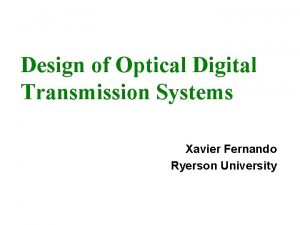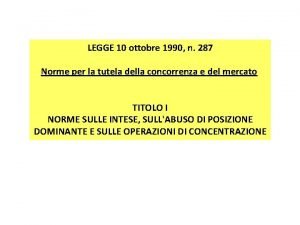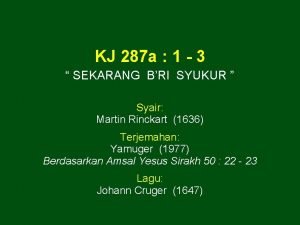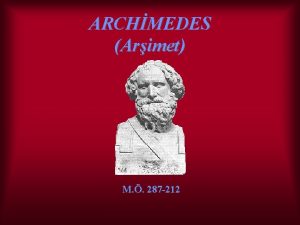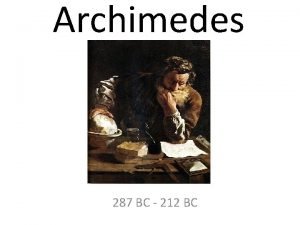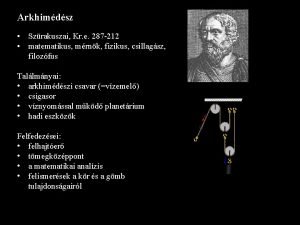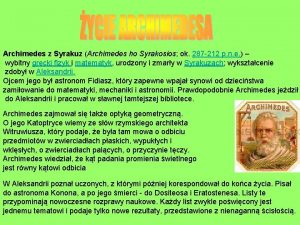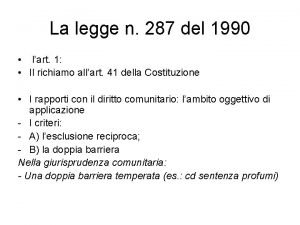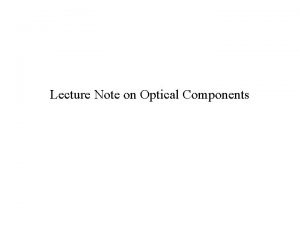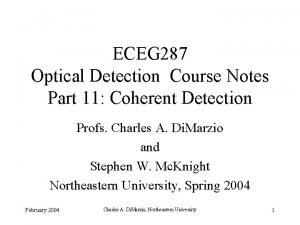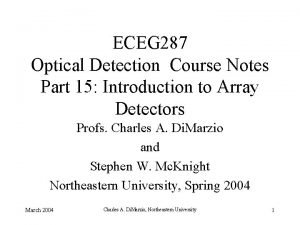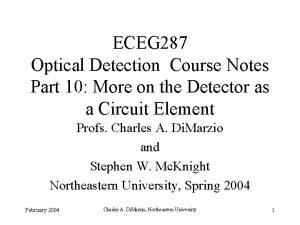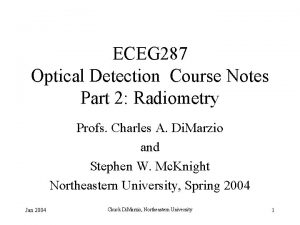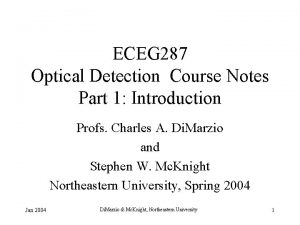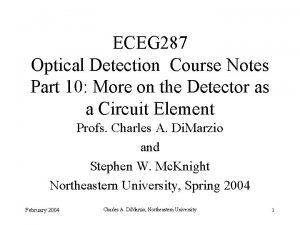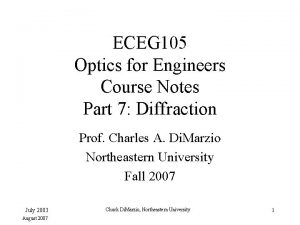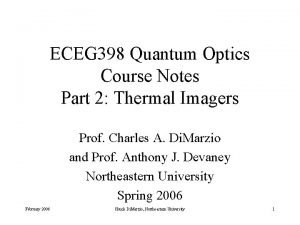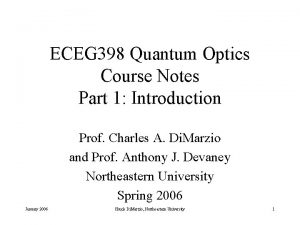ECEG 287 Optical Detection Course Notes Part 19














- Slides: 14

ECEG 287 Optical Detection Course Notes Part 19: Conclusion Profs. Charles A. Di. Marzio and Stephen W. Mc. Knight Northeastern University, Spring 2004 April 2004 Di. Marzio & Mc. Knight, Northeastern University 1

Electromagnetic Spectrum (by λ) UV= Near-UV: 0. 3 -. 4 μ Vacuum-UV: 100 -300 nm VIS= IR= 0. 40 -0. 75μ Near: 0. 75 -2. 5μ Mid: 2. 5 -30μ Extreme-UV: 1 -100 nm 10 nm =100Å 0. 1 Å γ-Ray April 2004 0. 1 μ Far: 30 -1000μ 1μ (300 THz) 1Å 10 Å X-Ray Soft X-Ray 1 mm Mm-waves Di. Marzio & Mc. Knight, Northeastern University 10 μ 100 μ = 0. 1 mm 1 cm 0. 1 m Microwaves RF 2

What is Optical Detection? • The goal is to get information from light. – Usually we look for variations in the amount of light over • • space. . . or time. . . or spectrum. . . or some combination of these. • Generally the output is an electrical signal. – It may be digitized for use in a computer. – We need to measure this signal in the presence of noise. April 2004 Di. Marzio & Mc. Knight, Northeastern University 3

Course Overview 2. Sources and Radiometry 3. Noise 2 -5. Detectors 7. Coherent Detection 8. Signal Statistics 9. Array Detectors April 2004 Di. Marzio & Mc. Knight, Northeastern University 6. Circuits 4

Some Detection Issues • Optics – Radiometry, Beam Shaping, and Filters • Detector Physics – Converting Optical Energy to Electrical • Receiver Circuit – Matching to Detector, Proper Biasing • Interpretation of Data – Dealing with Noise and Signal Statistics April 2004 Di. Marzio & Mc. Knight, Northeastern University 5

General Detector Issues • • Spectral Response Modulation Response Responsivity Noise (NEP) Damage Level Sensitive Area Circuit Considerations Device-Specific Issues April 2004 • Filtering – Angle, Position, Wavelength • Packaging – Window Transmission, Position • Power Requirements • Cooling/Vacuum Requirements Di. Marzio & Mc. Knight, Northeastern University 6

Square-Law Detector April 2004 Di. Marzio & Mc. Knight, Northeastern University 7

Noise Ps Signal + Noise Ps Pn April 2004 Di. Marzio & Mc. Knight, Northeastern University 8

Noise Issues • Optical Signal Power (Watts) – Normally Related to Some Desired Quantity (Reflectivity, Temperature, Distance, Magnetic Field, Scattering, Absorption, etc. ) • NEP (Watts per root Hertz) – Can be Related to “NEX” • Example: NEDT April 2004 Di. Marzio & Mc. Knight, Northeastern University 9

Two Basic Detection Concepts • Thermal Detectors Absorber hn Heat Sink Power: P Heating: (d. T/dt)H = CP Cooling: k(d. T/dt)C =(T-Ts) Steady State: (T-Ts)/k. C = P April 2004 • Photon Detectors i/P e- l Photon Energy: E=hn=hc/l Total Energy: Pt Photon Count: np=Pt/hn Electron Count: ne=hq. Pt/hn Electron Rate: ne/t=hq. P/hn Current: ene/t=(hqe/hn)P Di. Marzio & Mc. Knight, Northeastern University 10 Stopped Mon 5 Jan 04

Detector Types • Photon • Thermal – Characteristics • Wide Bandwidth • Accuracy – Examples • Thermocouple • Thermopile • Pyroelectric April 2004 – Characteristics • Speed • Sensitivity – Examples • Photoemissive • Photoconductive intrinsic & extrinsic • Photovoltaic intrinsic & extrinsic Di. Marzio & Mc. Knight, Northeastern University 11

Course Overview (1) • 3 - Noise and Photon Detectors • - Materials Considertations – (4) in Photoemissive Detectors – (5, 6) in Semiconductor Detectors • 7 - Types of Semiconductor Detectors • 8 - P-N Junction Effects & Other Detectors • 9, 10 - Detectors as Circuit Elements April 2004 Di. Marzio & Mc. Knight, Northeastern University 12

Course Overview (2) • 11, 12 - Coherent Detection • 13 - Semiconductor Photoconductive Detectors • 14 - Signals and Noise • 15 - Intro to Arrays & a bit about color • 16 - Gain & BW in Semiconductor Dets. • 17 - Array Detectors • 18 - Odds and Ends April 2004 Di. Marzio & Mc. Knight, Northeastern University 13

SNR Layout for Coherent Detection PLO Filter? Amp Preamp Ps PBKG April 2004 BPF Di. Marzio & Mc. Knight, Northeastern University 14
 Coherent detection in optical communication
Coherent detection in optical communication 287 pantone
287 pantone L. 287/1990
L. 287/1990 Kj 287
Kj 287 Archimedes ( arşimet) (mö 287–212 )
Archimedes ( arşimet) (mö 287–212 ) 287 bc
287 bc Intermediate school district 287
Intermediate school district 287 (1642-1727)
(1642-1727) Odkrycia archimedesa
Odkrycia archimedesa Legge 287 del 1990
Legge 287 del 1990 Optical amplifiers lecture notes
Optical amplifiers lecture notes Building with bricks
Building with bricks Course title and course number
Course title and course number Course interne moyenne externe
Course interne moyenne externe Wisc
Wisc
